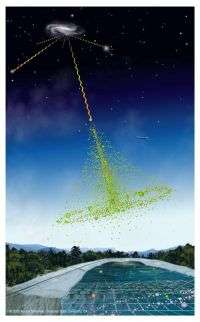Los Alamos observatory fingers cosmic ray 'hot spots'

A Los Alamos National Laboratory cosmic-ray observatory has seen for the first time two distinct hot spots that appear to be bombarding Earth with an excess of cosmic rays. The research calls into question nearly a century of understanding about galactic magnetic fields near our solar system.
Joining an international team of collaborators, Los Alamos researchers Brenda Dingus, Gus Sinnis, Gary Walker, Petra Hüntemeyer and John Pretz published the findings today in Physical Review Letters.
"The source of cosmic rays has been a 100-year-old problem for astrophysicists," Pretz said. "With the Milagro observatory, we identified two distinct regions with an excess of cosmic rays. These regions are relatively tiny bumps on the background of cosmic rays, which is why they were missed for so long. This discovery calls into question our understanding of cosmic rays and raises the possibility that an unknown source or magnetic effect near our solar system is responsible for these observations."
Cosmic rays are high-energy particles that move through our Galaxy from sources far away. No one knows exactly where cosmic rays come from, but scientists theorize they might originate from supernovae—massive stars that explode— from quasars or perhaps from other exotic, less-understood or yet-to-be-discovered sources within the universe.
Researchers used Los Alamos' Milagro cosmic-ray observatory to peer into the sky above the northern hemisphere for nearly seven years starting in July 2000. The observatory is unique in that it monitors the entire sky above the northern hemisphere. Because of its design and field of view, Milagro was able to record over 200 billion cosmic-ray collisions with the Earth's atmosphere.
"Our observatory is unique in that we can detect events of low enough energies that we were able to record enough cosmic-ray encounters to see a statistically significant fractional excess coming from two distinct regions of the sky," Dingus said.
Because cosmic rays are charged particles, magnetic fields from the Milky Way and our solar system change the flight paths of the particles so much that researchers had not been able to pinpoint their exact origin. Consequently, traditional wisdom has held that cosmic-ray events appear uniformly throughout the sky.
But because Milagro was able to record so many cosmic-ray events, researchers for the first time were able to see statistical peaks in the number of cosmic-ray events originating from specific regions of the sky near the constellation Orion. The region with the highest hot spot of cosmic rays is a concentrated bulls eye above and to the right visually of Orion, near the constellation Taurus. The other hot spot is a comma-shaped region visually occurring near the constellation Gemini.
The researchers created a graphic depiction of the hot spots that makes them appear as a pair of red cosmic rashes in a field of stars.
Milagro scientists are currently working with researchers in Mexico to build a second-generation observatory known as the High-Altitude Water Cherenkov (HAWC) experiment. If built, the HAWC observatory could help researchers solve the mystery of cosmic-ray origin.
Source: Los Alamos National Laboratory




















